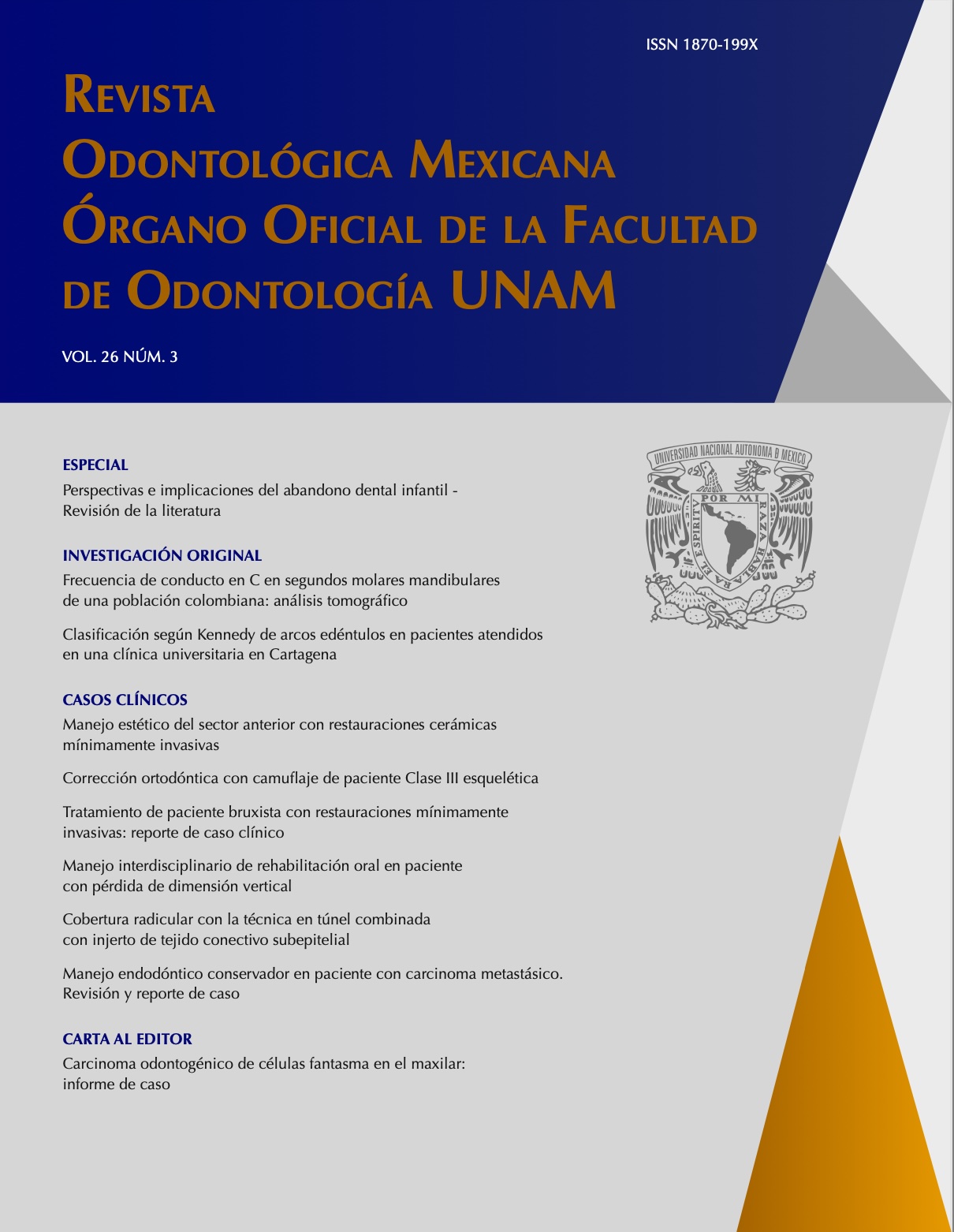Frequency of C-shaped Root Canal in Mandibular Second Molars of a Colombian Population: Tomographic Analysis
Main Article Content
Abstract
Introduction: The C-shaped root canal system is a common anatomical variation in mandibular second molars with root fusion, with a prevalence of 2.7% to 44.5%. Objective: To estimate the frequency of C-shaped root canals in mandibular second molars by means of computed tomography scans taken from patients who attended radiological centres. Materials and methods: A total of 120 mandibular second molars were evaluated. The frequency and type of C-shaped root canal were determined according to the gender and location of the tooth. Invivo5 software was used. For statistical analysis the Chi-squared test (p=0.05) was performed. The C-shape root canal was categorized based on Fan's classification and the presence of notches and grooves based on the classification of Shemesh et al. 2017. Results: The frequency of C-shaped root canals in the studied population was 25%, with a significant difference in terms of gender. The C-shaped root canal at the level of the cervical and apical root thirds was more frequent for type II and in the middle for type III. It was found that 6.7% of the studied population had type I according to the Shemesh et al. classification, the right side occurring more frequently (62.5%); while 3.4% had type III where the left side happened more frequently (75%). Conclusions: This is one of the few studies carried out in Colombia related to the frequency of the C-shaped root canals, and it was determined that there is a higher frequency in the female gender (33.3%).
Article Details
Citas en Dimensions Service
References
Cooke HG, Cox FL. C-shaped canal configurations in mandibular molars. J Am Dent Assoc. 1979; 99(5): 836-839. DOI: 10.14219/jada.archive.1979.0402
Sherwood IA, Gutmann JL, Kumar S, Evangelin J, Nivedha V, Sadashivam V. CBCT analysis of the anatomy of C-shaped root canals in mandibular second molars from a southern Indian population in Tamil Nadu. Endodontic Practice Today. 2019; 13(1): 61–70
Shemesh A, Levin A, Katzenell V, Itzhak JB, Levinson O, Avraham Z, et al. C-shaped canals —prevalence and root canal configuration by cone beam computed tomography evaluation in first and second mandibular molars— a cross-sectional study. Clin Oral Investig. 2017; 21(6): 2039-2044. DOI: 10.1007/s00784-016-1993-y
Ren HY, Zhao YS, Yoo YJ, Zhang XW, Fang H, Wang F, et al. Mandibular molar C-shaped root canals in 5th millennium BC China. Arch Oral Biol. 2020;117: 104773. DOI. 10.1016/j.archoralbio.2020.104773
Jafarzadeh H, Wu YN. The C-shaped root canal configuration : A review. J Endod. 2007; 33(5): 517-523. DOI: 10.1016/j.joen.2007.01.005
Melton DC, Krell KV, Fuller MW. Anatomical and histological features of C-shaped canals in mandibular second molars. J Endod. 1991; 17(8): 384-388. DOI: 10.1016/S0099-2399(06)81990-4
Fan B, Cheung GSP, Fan M, Gutmann JL, Bian Z. C-shaped canal system in mandibular second molars : Part I — anatomical features. J Endod. 2004; 30(12): 899-903. DOI: 10.1097/01.don.0000136207.12204.e4
Martins JNR, Mata A, Marques D, Caramês J. Prevalence of root fusions and main root canal merging in human upper and lower molars : A cone-beam computed tomography in vivo study. J Endod. 2016; 42(6): 900-908. DOI: 10.1016/j.joen.2016.03.005
Martins JNR, Marques D, Silva EJNL, Caramês J, Mata A, Versiani MA. Prevalence of C-shaped canal morphology using cone beam computed tomography – a systematic review with meta-analysis. Int Endod J. 2019; 52(11): 1556-1572. DOI: 10.1111/iej.13169
Quijano S, García C, Rios K, Ruiz V, Ruíz A. Sistema de conducto radicular en forma de C en segundas molares mandibulares evaluados por tomografía cone beam. Rev Estomatol Herediana. 2016; 26(1): 28-36. http://www.scielo.org.pe/scielo.php?script=sci_arttext&pid=S1019-43552016000100005
Kato A, Ziegler A, Higuchi N, Nakata K NH, Nakamura H, Ohno N. Aetiology, incidence and morphology of the C shaped root canal system and its impact on clinical endodontics. Int Endod J. 2014; 47(11): 1012-1033. DOI: 10.1111/iej.12256
Silva EJNL, Nejaim Y, Silva AV, Haiter-Neto F, Cohenca N. Evaluation of root canal configuration of mandibular molars in a Brazilian population by using cone-beam computed tomography : An in vivo study. J Endod. 2013; 39(7): 849-852. DOI: 10.1016/j.joen.2013.04.030
Torres A, Jacobs R, Lambrechts P, Brizuela C, Cabrera C, Concha G, et al. Characterization of mandibular molar root and canal morphology using cone beam computed tomography and its variability in Belgian and Chilean population samples. Imaging Sci Dent. 2015; 45(2): 95-101. DOI: 10.5624/isd.2015.45.2.95
Fan B, Cheung GSP, Fan M, Gutmann JL, Fan W. C-shaped canal system in mandibular second molars: Part II — radiographic features. J Endod. 2004; 30(12): 904-908. DOI: 10.1097/01.don.0000136206.73115.93
Martins JNR, Francisco H, Ordinola-Zapata R. Prevalence of C-shaped configurations in the mandibular first and second premolars: A cone-beam computed tomographic in vivo study. J Endod. 2017; 43(6): 890-895. DOI: 10.1016/j.joen.2017.01.008
Alkaabi W, Aishwaimi E, Farooq I, Goodis HE, Chogle SMA. A micro-computed tomography study of the root canal morphology of mandibular first premolars in an Emirati population. Med Princ Pract. 2017; 26(2): 118-124. DOI: 10.1159/000453039
von Zuben M, Martins JNR, Berti L, Cassim I, Flynn D, Gonzalez JA, et al. Worldwide prevalence of mandibular second molar C-shaped morphologies evaluated by cone-beam computed tomography. J Endod. 2017; 43(9): 1442-1447. DOI: 10.1016/j.joen.2017.04.016
Ávila-Gomez JA, Vega-Lizama EM, López-Villanueva ME, Alvarado-Cárdenas G, Ramírez-Salomón MA. Bilateralidad de segundos molares mandibulares con conductos en C. Rev Odontol Latinoam. 2012; 4(2): 33-36. https://www.odontologia.uady.mx/revistas/rol/pdf/V04N2p33.pdf
Janani M, Rahimi S, Jafari F, Johari M, Nikniaz S, Ghasemi N. Anatomic features of C-shaped mandibular second molars in a selected Iranian population using CBCT. Iran Endod J. 2018; 13(1): 120-125. PMID: 29692847
Kim SY, Kim BS, Kim Y. Mandibular second molar root canal morphology and variants in a Korean subpopulation. Int Endod J. 2016; 49(2): 136-144. DOI: 10.1111/iej.12437
Alfawaz H, Alqedairi A, Alkhayyal AK, Almobarak AA, Alhusain MF, Martins JNR. Prevalence of C-shaped canal system in mandibular first and second molars in a Saudi population assessed via cone beam computed tomography: A retrospective study. Clin Oral Investig. 2019; 23(1): 107-112. DOI: 10.1007/s00784-018-2415-0

Revista Odontológica Mexicana por Universidad Nacional Autónoma de México se distribuye bajo una Licencia Creative Commons Atribución-NoComercial-SinDerivar 4.0 Internacional.
Basada en una obra en http://revistas.unam.mx/index.php/rom.


